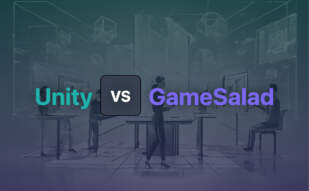Reality Composer Pro is an AR authoring tool by Apple, offering easy prototype and production of AR experiences without prior 3D experience. It allows users to drag, drop, place, and rotate virtual 3D objects within scenes, along with advanced LiDAR sensor-enabled 3D model creation.
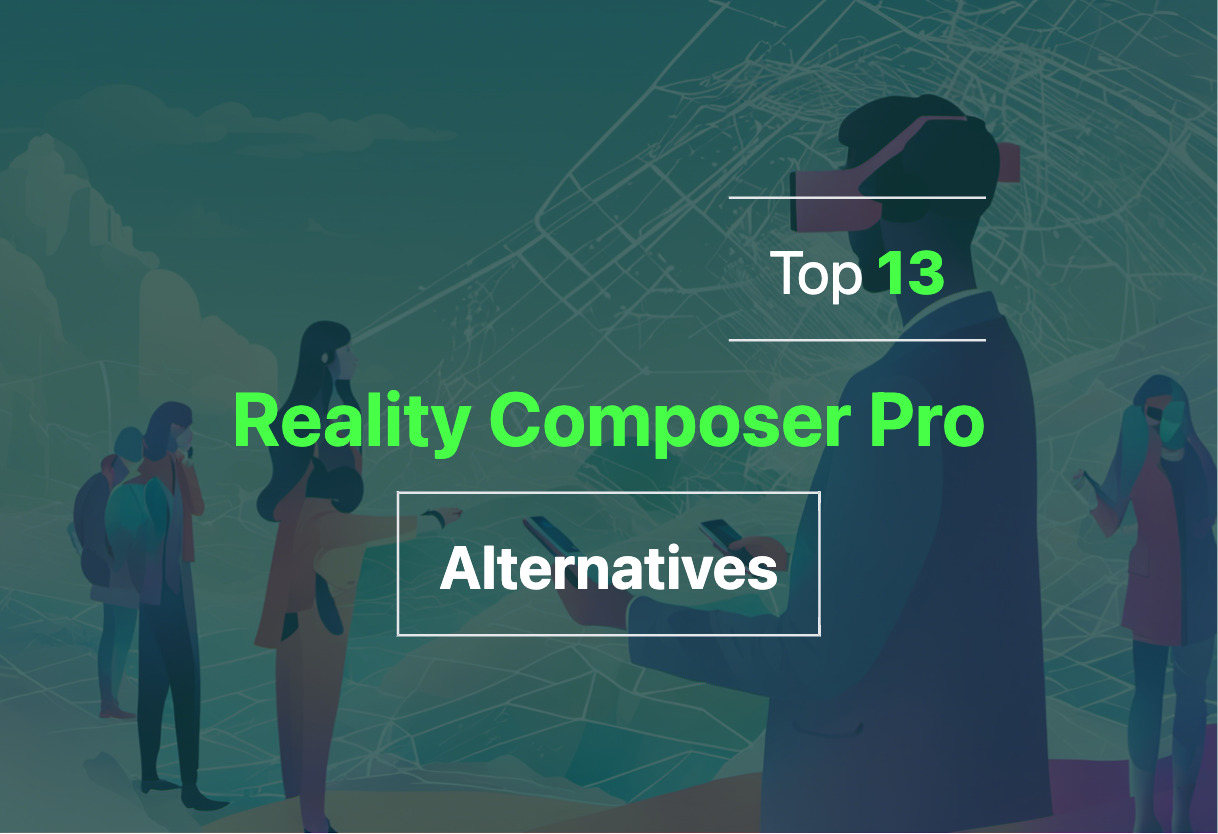
For those exploring alternatives to Reality Composer Pro, options include Unity, Unreal Engine, Stride, Babylon.js, Three.js, GameSalad, Phaser, Roblox, jMonkeyEngine, GameMaker, Construct 3, RPG Maker, and SpriteKit.
Unity

Enter the world of Unity, launched in 2005, a platform that revolutionizes the realm of 3D and 2D game development. Steeped in power and adaptability, Unity takes your gaming dreams and scales them up to epic, tangible realities, compatible across Android and iOS.
Unity Top Features
- Offers a suite of tools to assist high-quality game creation.
- Adaptable with several operating systems.
- Packed with a range of applications from Augmented Reality to 3D simulations.
- Rich asset store featuring diverse pre-designed textures and features.
- Supports multiple coding languages such as BOO script, JavaScript, and C#.
| Community | Active developer community facilitating assistance and feedback for system improvement. |
| Learning | Promotes constant learning and application of new industry solutions. |
| Collaboration | Committed to increasing adaptability and collaboration among members, thereby powering up game development. |
Unity Limitations
- Upcoming pricing model initiating install fees could harm solo and indie developers.
- Potential for abuse of per-install fees through repeated downloads by a single user.
- Open mistrust due to sudden unannounced changes and retroactive fee structures.
Unity Pricing
Get ready for a new pricing model effective January 1, 2024 with developers paying a fee each time a Unity software-based game is installed. Game installs exceeding 200,000 and revenue over $200,000 are in the chargeable zone. But worry not, Unity is all set to ensure fair play. Unity will be introducing fraud detection practices to preclude additional costs for pirated copies. Games deployed in US, UK attract higher fees than those in emerging markets like India and China.
Unity Use Cases
Use Case 1: Mobile Game Development
Unity is designed with strong compatibility for mobile games, making it a go-to choice for mobile game developers.
Use Case 2: Indie Game Development
Despite potential pricing concerns, Unity offers robust toolsets and an active community, making it a significant platform for Indie developers.
Use Case 3: AR/VR Game Development
Unity revolutionizes game experiences by fostering the creation of AR/VR features, perfect for immersive game design.
Unreal Engine
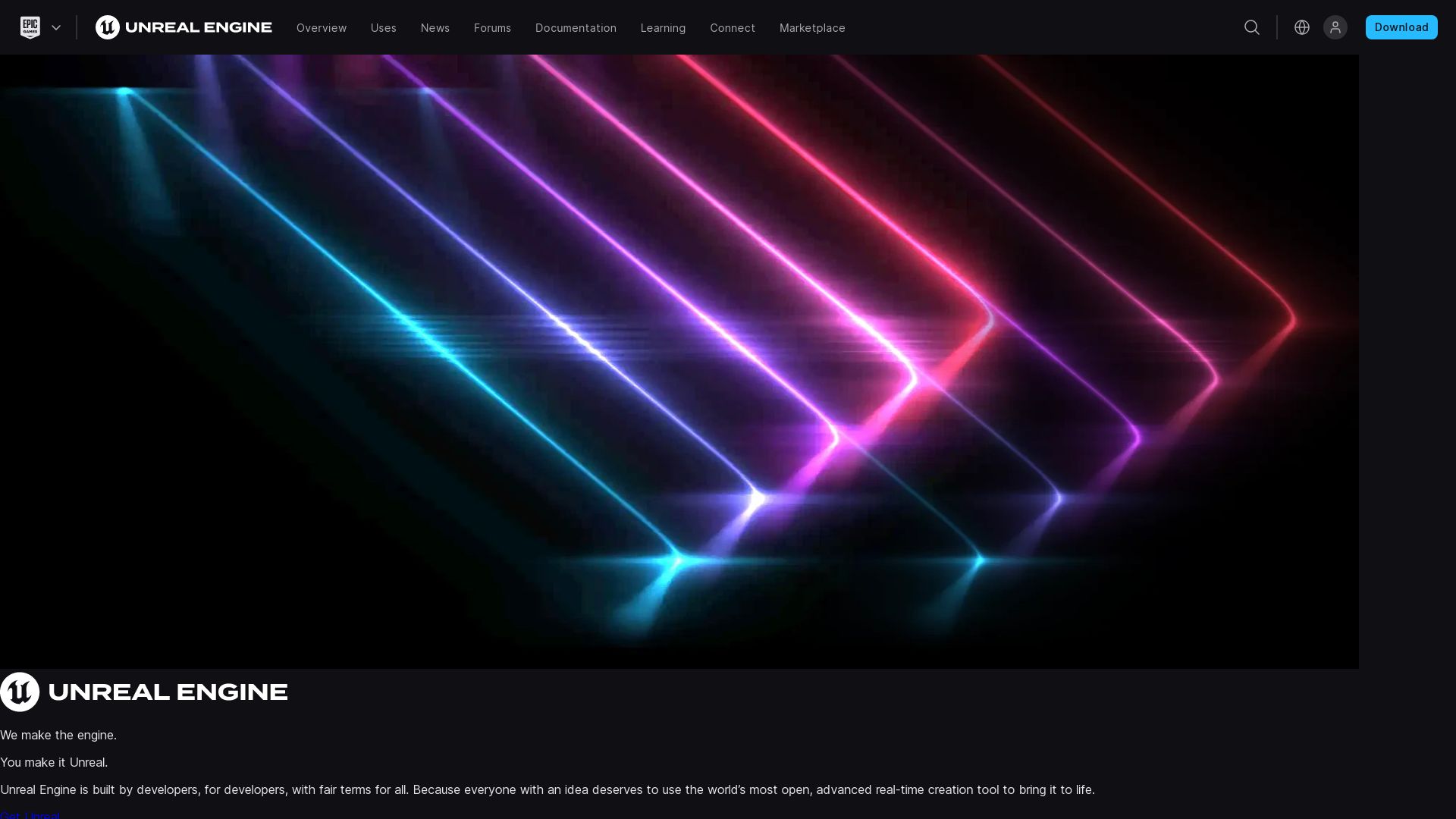
Manufactured by Epic Games, Unreal Engine is a powerful suite of 3D game engines, initially used in first-person shooter games. Boasting wide range capabilities, it has found applications in several industries, including film & TV. Written in C++, it supports diverse platforms – from desktop and mobile to console and VR.
Unreal Engine Top Features
- Supports a broad spectrum of platforms, including mobile, desktop, console, and virtual reality
- Armed with UnrealEd, a level editor supports real-time constructive solid geometry operations
- Includes features from the likes of Quixel
- Allows content creators to sell creations or purchase work of other developers via Unreal Engine Marketplace
- Offers free usage to schools and universities
- Uses C++ as the language for game development.
| Feature | Explanation |
|---|---|
| Unreal Development Kit | Includes support for iOS games and apps creation. |
| Basic Project Templates | Serves as a starting point for a first-person or third-person experience. |
| Strategic Alliances | Expanding the reach of the software globally. |
Unreal Engine Limitations
- Complex for beginners
- Heavy on system resources
Unreal Engine Pricing
Epic Games has laid down an interesting business model for its commercial users. They charge 5% royalty on the revenues accrued over 1 million USD while this fee is waived if the games are published on Epic Games Store itself.
Unreal Engine Use Cases
Game Development
Unreal Engine is a robust platform for creating games across genres, which was proven when ‘Daylight’ the first title using Unreal Engine 4 was launched.
VR Creation
The flexibility of Unreal Engine has enabled its application in VR content creation as well because of its substantial VR platform support.
Educational Purpose
Universities and schools can use Unreal Engine free, allowing students to experiment and learn from this advanced game development platform.
Construct 3

Construct 3 is a robust 2D game engine developed by Scirra with a unique visual programming approach through ‘event sheets’ that helps you swiftly pull together games. This HTML5-based engine is designed for both beginners and professional developers, with convenient browser-based accessibility and offline support.
Construct 3 Top Features
- Event Sheets: This unique feature reduces the dependency on traditional coding, using logic-based actions triggered by conditional statements.
- Pixel Editor in-built: Convenient pixel editor for game graphics creation.
- Extensive Behaviors Support: Solid, platformer, tile movement, anchor and others behaviors enhance the game performance.
- HTML5 Compliance: Supports Chrome, Firefox, IE 9+, Safari 6+, Opera 15+ browsers making it ideal for browser-based games.
| Educational Use | Used by 400 schools across 48 states in the US. |
| Versatility | Ideal for simple to medium-size 2D games. |
| JavaScript Integration | Released in May 2019, offering flexibility for advanced users. |
Construct 3 Limitations
- Not viable for 3D game development.
- Limited Native Exporters: Game export relies on a web app or HTML wrapper.
- Unable to support Apple TV and similar platforms due to lack of offline application behavior.
- Limited in creating large-sized games due to software constraints.
Construct 3 Pricing
Scirra offers both a free and a paid version of Construct 3, with the annual subscription of the paid version starting at $99. The paid version comes with additional features to enhance game development.
Construct 3 Use Cases
Use case 1 – Indie Developers
With its easy-to-use interface, robust features, and JavaScript integration, Construct 3 enables indie developers to create visually-rich 2D games without the steep learning curve of traditional coding.
Use case 2 – Educators
Construct 3 is widely used by educators and schools to teach coding and game development. Its ease of use, downloadable features, and compliance with data privacy regulations (COPPA, CCPA, and GDPR), make it an ideal tool for educational use.
Use case 3 – Professional Developers
Construct 3’s versatility, language integration, and online interface similar to industry-grade engines, enables professional developers to create advanced 2D games efficiently.
RPG Maker
Brought into existence by ASCII, Enterbrain, Agetec, and Degica, RPG Maker is a revered AR Creation Tool perfect for developing Role Playing Games (RPGs) with a compelling, story-driven design. With its inception in 1992, the platform has thrived across multiple devices and operating systems, birthing a multitude of sprite-based, 2D perspective games reminiscent of the classic Final Fantasy series.
RPG Maker Top Features
- No Coding Knowledge Necessary: The latest iteration, RPG Maker MV, presents an easy-to-use interface accessible to developers of all experience levels.
- Robust Character Customization: The tool boasts extensive character creation and customization options.
- Versatile Game Development: RPG Maker includes support for a wide range of platforms including Windows, Mac, Xbox One, Nintendo Switch, and PlayStation.
| Feature | Description |
|---|---|
| Plugins | With RPG Maker, developers can implement a multitude of free plugins, expanding the flexibility of the platform. |
| DLCs | Over 200 DLCs are available for RPG Maker MV, broadening the scope for game development. |
| Community Support | An active community fosters growth and knowledge sharing, fortifying RPG Maker’s reliability. |
RPG Maker Limitations
- Engine Limitations: Certain game designs are constrained by the engine’s limitations which require a skilled developer to overcome.
- Creativity Requirement: A game risks being unsuccessful without the input of creative ingenuity and vision.
RPG Maker Pricing
RPG Maker offers over 200 additional downloadable content (DLCs) for their latest iteration, RPG Maker MV, with prices ranging from $5 to $25.
RPG Maker Use Cases
Use case 1
RPG Maker thrives in Story-driven RPG Development, with the creative potential able to focus on narrative, character interaction, and unique decision path engagement.
Use case 2
The tool can be instrumental for Novice Developers, eager to learn about game development using an intuitive and user-friendly interface.
Use case 3
For Experienced Developers, RPG Maker provides an excellent stage for showcasing creativity, overcoming limitations, and creating games that spark conversations and elicit strong player reactions.
SpriteKit
![]()
SpriteKit is a robust game development framework concocted by Apple, predominantly for iOS and macOS. It assists developers in creating interactive and dynamic 2D games. With a foundation over the SceneKit framework, this tool maximizes efficiency and user-friendliness, while implementing physics-oriented gameplay and captivating animations.
SpriteKit Top Features
- Scene, Node, Sprite, Action: The four major SpriteKit components offering an enhanced gaming experience.
- Box2D Physics Engine: Empowers realistic object interactions in games.
- Swift Language Support: Swift amplifies code efficiency and provides sample codes for ease of game creation.
- Advanced Game Capabilities: Features like scene editing, animation, physics and particle systems ensure a comprehensive 2D gaming environment.
- Apple Support: Guaranteed support from Apple for integration with future devices.
| Platform Compatibility | iOS, macOS |
| Architecture Compatibility | 64-bit architecture of iPhone 5S |
| Development Language | Swift |
SpriteKit Limitations
- Restricted Ecosystem: SpriteKit development is exclusive to Apple, limiting cross-platform possibilities.
- Alpha Masking vs Performance: For superior collision accuracy, alpha masking is useful but affects overall performance.
- Circular Shape vs Collision Accuracy: Implementing a circular shape can contribute to better performance, albeit compromising collision accuracy.
SpriteKit Use Cases
Use case 1: Game Development
With its exceptional capabilities like physics-based interactions, SpriteKit is a strong candidate for developers creating immersive 2D games on iOS or macOS platforms.
Use case 2: MVP Development
SpriteKit’s high speed and efficiency make it suitable for the Minimum Viable Product(MVP) methodology in game development, helping to validate a game’s concept as quickly as possible.
Use case 3: Game Analytics
For understanding player behaviour and improving game design, SpriteKit’s robust mechanisms, combined with efficient game analytics, can provide significant insights in this area.
Stride
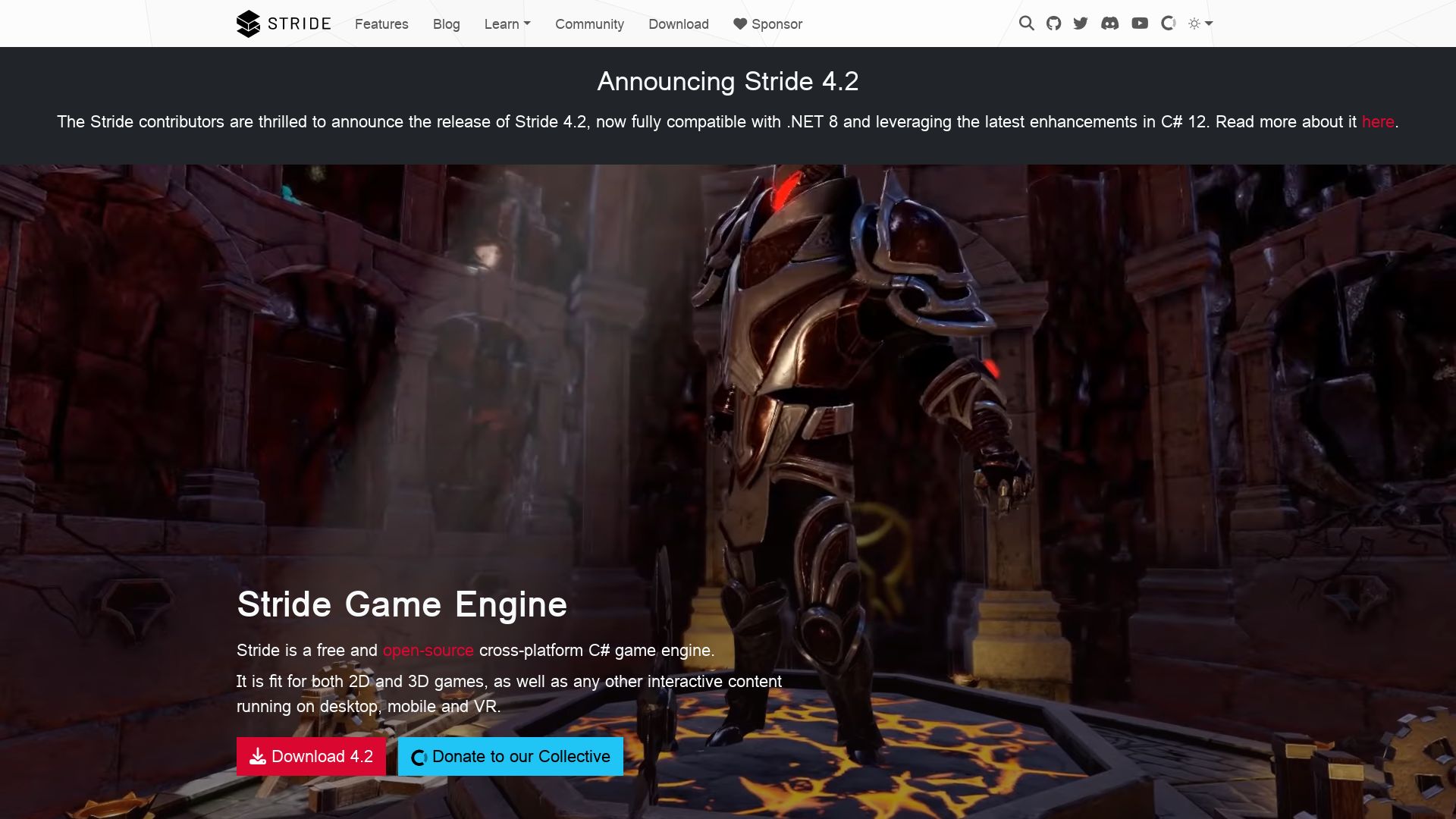
From the famed creators at Silicon Studio comes Stride, a cross-platform and open-source 3D game engine initially known as Xenko. An integrated entity that aids in the creation of video games for various platforms such as PC, virtual reality, and mobile devices, Stride operates with efficacy, making it a viable alternative to Reality Composer Pro.
Stride’s Supreme Features
- C# suite tools: Elevates coding to new heights with its impeccable flexibility and efficiency.
- Customizable shader system: Enables developers to shape graphical effects to their whim.
- Integrated environment for asset import, scene creation, and arrangement using Entity component system, script assignment, game building and running: Makes game development seamless and efficient.
- Scene editor and PBR Material editor: Introduced in March 2015, these tools facilitate the creation of authentic environments.
| Feature | Benefit |
|---|---|
| Physically-Based Rendering (PBR) | Allows realistic shading and rendering |
| Photorealistic Postprocess effects | Enhances the game’s visual appeal |
Stride’s Slight Downsides
- There was a sudden cease in support from Silicon Studio in August 2018, leading Stride to become a community-led project.
- Bearing open-source status, the Stride community can be a bit small, and therefore, finding immediate help or resources can be challenging.
Stride’s Pricing
Stride is open-source and absolutely free, allowing an expansive playground for developers to thrive.
Stride Use Cases
Use Case 1: Game Development
Primed for video game creation, Stride is an excellent choice for novice and professional developers alike, owing to its assorted tools and options.
Use Case 2: VR Exploration
Stride permits developers to dive into the enthralling depths of virtual reality, presenting an open canvas for VR experiences.
Use Case 3: Cross-platform development
Stride extends its prowess beyond boundaries, facilitating game development for iOS, Android, Windows UWP, and PlayStation 4, thereby making it ideal for cross-platform development.
Babylon.js
Introducing Babylon.js, a real-time 3D engine that allows for high-definition 3D graphics display via HTML5 in a web browser. Developed by Microsoft along with various other contributors, it has roots in a former game engine built for Silverlight’s WPF based 3D system.
Babylon.js Top Features
- Written in TypeScript and JavaScript;
- Its code is compiled from TypeScript to JavaScript, making it easily accessible to users via NPM or CDN;
- Provides physically based rendering and post-processing methods for photo-realistic images;
- Utilizes plug-in physics engines Cannon.js and Oimo to simulate real-world physical reactions;
- Performs complex animation via key frame animation objects and skeletons with blend weights.
| Original Author | David Catuhe |
| Developed By | Microsoft, Other Contributors |
| License | Apache License 2.0 |
Babylon.js Limitations
- Limited usage of constructive solid geometry for union, subtraction, and intersection of shell models.
Babylon.js Pricing
As per the given data, Babylon.js is an open-source engine with its source code accessible via GitHub
Babylon.js Use Cases
Use case 1 – Virtual Worlds
With Babylon.js, creating virtual worlds becomes a manageable task. Its complex animation and physics simulation capabilities can deliver an immersive virtual experience.
Use case 2 – Education in Medicine
Babylon.js can be used to model anatomy and visualize medical procedures, creating revolutionary educational resources in medicine.
Use case 3 – Military Training
With its 3D rendering and physics simulation, Babylon.js can aid in creating realistic military training programs.
Three.js
Developed by Ricardo Cabello, a.k.a Mr.doob and a robust community of developers, Three.js is a powerful, cross-browser JavaScript library hosted on Github. Since its initial release on April 24, 2010, Three.js specializes in producing animated 3D computer graphics in a web browser without requiring additional plugins, utilizing WebGL and GLSL.
Three.js Top Features
- WebGL-accelerated 3D animations: Leverages the power of GPU for creating stunning animations in JavaScript.
- WebXR Support: Provides a comprehensive foundation for both Augmented and Virtual Reality.
- Multiple Features: Offers a myriad of features such as scenes, cameras, lights, materials, shaders, objects, and geometry.
- Cross-browser Support: Runs in all browsers that support WebGL 1.0.
| License | MIT |
| Language | JavaScript, GLSL |
| Contributors on Github | Over 1700 contributors |
Three.js Limitations
- Utilizes WebGL 1.0, which may not be supported by older devices and browsers.
- Complex animations require high-level libraries, potentially leading to higher learning curves.
- Lack of clear documentation might pose a challenge to beginners.
Three.js Pricing
Three.js is open source and available for free under the MIT License.
Three.js Use Cases
Use Case 1: 3D Modelling
Three.js is leveraged extensively for creating complex 3D models and animations for a rich, immersive web experience.
Use Case 2: Multimedia Applications
Utilized in multimedia applications offering significant multilevel user interaction, enhancing user engagement.
Use Case 3: Augmented and Virtual Reality
With its in-built WebXR support, Three.js forms the backbone of many AR/VR applications, contributing to creating realistic experiences.
GameSalad
Emerging as a digital game changer, GameSalad is a free game creation engine harnessing drag-and-drop technology. Championing diverse platforms such as iOS, Android and HTML5, this innovative toolkit offers both beginners and professionals a playground to manifest game designs that metamorphose cross-platform play.
GameSalad Top Features
- Intuitive drag-and-drop coding platform that promotes STEAM learning through game creation.
- Versatile In-App Previewer for real time testing and validation of game designs.
- Empowering web publishing system for cross-platform publishing, harmonizing the gaming experience across Android, iOS, Windows, and the Amazon Marketplace.
- GameSalad Pro offers an enriched feature set including social elements, monetization options and more.
- Offers a comprehensive education program in collaboration with global schools and educators, reinforcing logic-based thinking and problem-solving skills.
| Feature | Description |
| Scene Editor | Visual interface to create and arrange game environments. |
| Integrated Physics | Provides realistic, physics-based stimulation for game elements. |
| Expressions | Allows for deeper customization and control over game behavior and logic. |
GameSalad Downsides
- Laid off half of its staff between October-November 2012 which potentially could affect its service standards.
- Discontinued free memberships in 2015, limiting access for indie developers and hobbyists.
GameSalad Pricing
Whilst GameSalad Pro confers an expanded experience with richer features, monetization options and more, it does levy a pricing tier. Special discounts are however extended to students, educators, and the US Military.
GameSalad Use Cases
Use Case 1: Education
GameSalad provides a fertile ground for educators and learners to delve into computer science concepts and design-thinking aspects. Through a collaboration with institutions such as Connally High School, Texas and James B. Conant High School, Illinois, GameSalad is at the forefront of digital education.
Use Case 2: Game Developers
Offering extensive tutorials on platforms like YouTube and at GameSalad Academy, this platform is a considerable resource for both budding and seasoned game developers seeking to create games for diverse platforms and marketplaces.
Use Case 3: Independent Creators and Hobbyists
With an intuitive interface that doesn’t require coding knowledge, it encourages user-generated creation. Despite the discontinuation of its free membership, GameSalad still caters to indie creators with its Free-to-Make model, albeit with limitations.
Phaser
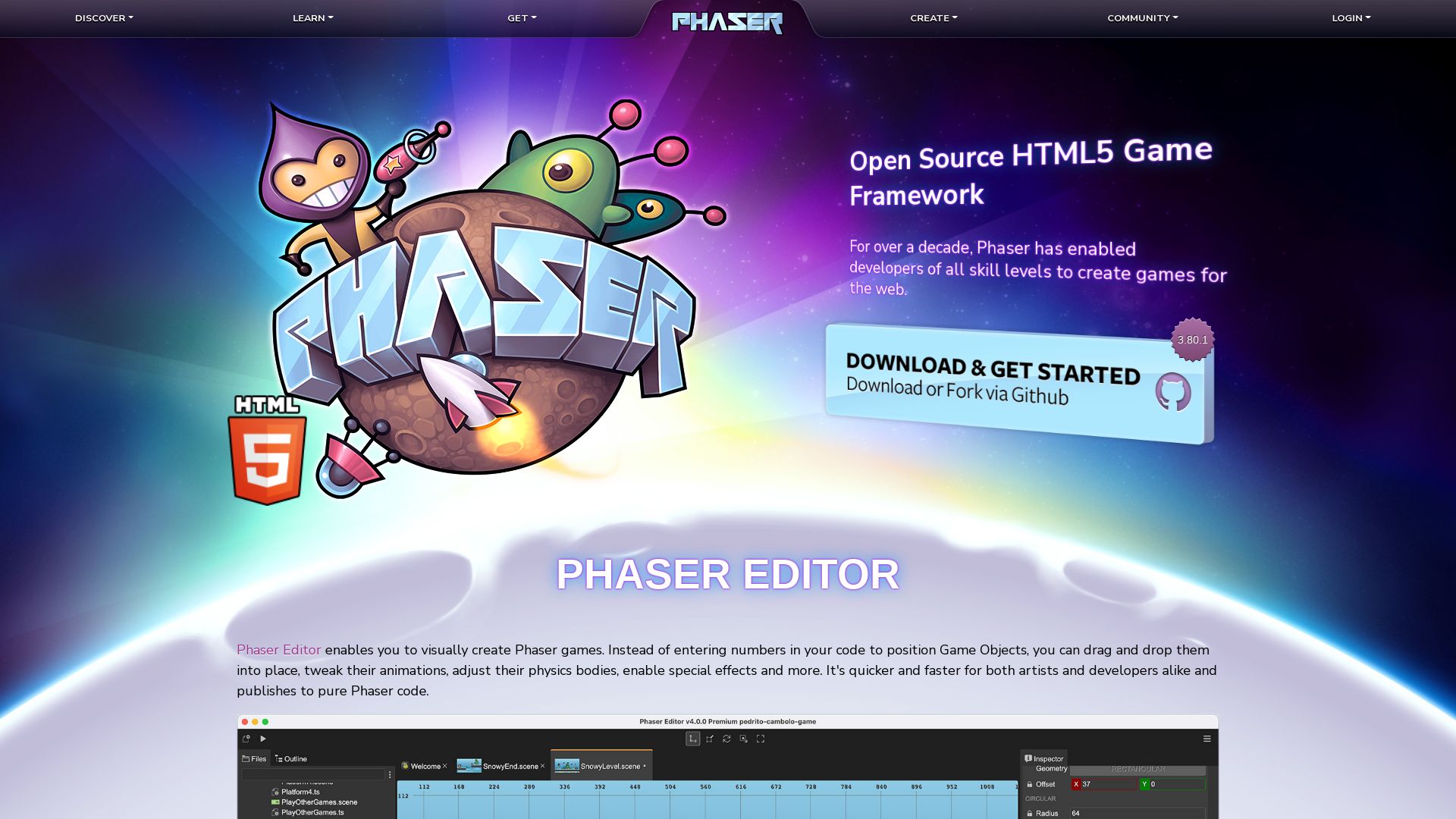
Immersing gamers into digital landscapes since 2013, Phaser is a fully equipped framework for mobile and desktop HTML5 game creation. It was invented by the talented Richard Davey and since its initial release, has experienced several enhancements, with each version better than the last. Enhanced by JavaScript and TypeScript, it automatically switches between Canvas and WebGL rendering for optimal speed, depending on the browser’s support capabilities.
Phaser Top Features
- It offers full support for mobile games, making it deployable to iOS and Android platforms and native desktop apps via tools like Apache Cordova and PhoneGap.
- It provides support for multiple physics systems including Arcade Physics, Ninja Physics, and P2.JS.
- Web and HTML5 audio capabilities for sound playback enhance game interaction.
| Feature | Description |
|---|---|
| Framework | Scripted in JavaScript with TypeScript enhancements, it operates on a modular structure that is easily customizable. |
| Community Support | An active community of developers provides regular updates and improvements. Over 1800 examples make game development a breeze. |
| Assets | A dedicated folder system for scripts, source files, and other data ensures seamless organization of your game project. |
Phaser Limitations
- Lack of a built-in scene editor can increase the complexity of game development.
- Its performance may get affected when handling intensive 3D games.
Phaser Pricing
Phaser is an open-source project. All versions are available for free on GitHub, allowing anyone with an interest in game development to use and modify it for their needs.
Phaser Use Cases
Use case 1: Beginners in Game Development
If you’re new to game development and looking for a platform to jumpstart your journey, Phaser’s robust and well-supported resources are perfect for you, making it an ideal starting point.
Use case 2: Professional Game Developers
For professional developers seeking a powerful and flexible tool for creating advanced applications, Phaser’s versatile and modular nature serves as a breeding ground for innovation.
Use case 3: Educators and Tutors
Teachers and self-learners alike can utilise Phaser as an educational resource for teaching the fundamentals of game development, with Phaser Mini-Degree from Zenva Academy offering an insightful and beginner-friendly course.
Roblox

Founded by David Baszucki and Erik Cassel, Roblox has been a bastion of creativity and innovation since its inception in 2006. It has established itself as a massive online platform for game creation and gameplay, facilitating a user-generated content library akin to YouTube in the gaming industry.
Roblox Top Features
- Proprietary Engine, Roblox Studio: Enables users to create games.
- Vast User-Generated Content Library: Offers over 50 million user-created games.
- Strong User Engagement: Records show over 100 million monthly active users.
- Collaborative Development: Encourages unstructured play and has a noted respect for mutual support.
- Platform Compatibility: Facilitates game development for various platforms (Windows, macOS, iOS, Android, Xbox One, Meta Quest 2, Meta Quest Pro, PlayStation 4).
| Feature | Benefit |
|---|---|
| Robux (Virtual Currency) | Eases in-app purchases and can be financially rewarding to creators. |
| Integration with External Software like Blender | Assists with modelling and animation within games. |
| Wide Teaching Resources | Facilitates learning of game development basics and Roblox programming languages through online classes, books, and YouTube tutorials. |
Roblox Limitations
- Critical Reviews: Has faced scrutiny for reports of adult content and misuse by adult players.
- Moderation Issues and Microtransactions: Despite robust safety measures, has been criticized over these concerns.
- Allegations of Child-Exploitative Practices: Has been controversial due to such allegations.
Roblox Pricing
Roblox offers free access to its platform, bolstering creativity and innovation, although in-app purchases are supported through a virtual currency, Robux.
Roblox Use Cases
Use case 1 – Aspiring Game Developers
The proprietary engine, Roblox Studio, and the vast availability of learning resources make Roblox a powerful tool for budding-game developers seeking to hone their skills and creativity.
Use case 2 – Freelancers and Small Businesses
With its strong sense of community and mutual support, Roblox provides a promising platform for freelancers and small businesses to generate revenue through game creation and Robux.
Use case 3 – Online Socializers
Roblox’s social interaction features, like friend addition and chat functionality, along with user-generated games, offer an excellent platform for users seeking online socialization within a creative environment.
jMonkeyEngine
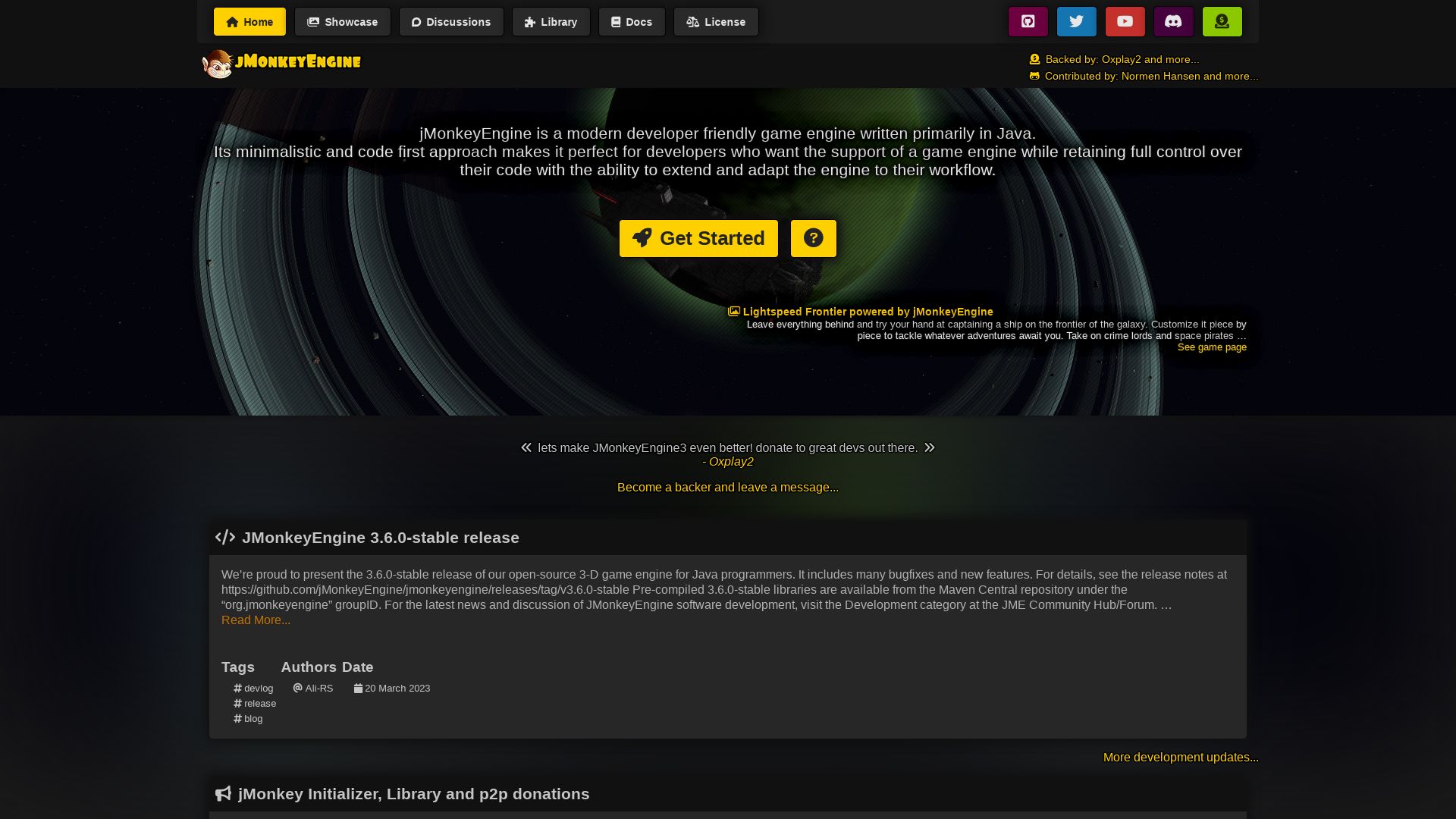
jMonkeyEngine is an open-source, Java-based game engine that targets developers with a code-first approach. Boasting compatibility with a variety of platforms, it offers state-of-the-art features like 3D audio support and post-processing out-of-the-box.
jMonkeyEngine Top Features
- NetBeans Platform – Built on a robust, industry-standard platform.
- Android-Capable – Extend your games to Android devices.
- Code-first Approach – Prioritizes programming and direct control over the game environment.
- Multi-platform Compatibility – Physical games can be published to PC, Linux, iOS, Android, and Mac.
- 3D Audio Support – Immersive sound experiences right out of the box.
| 3.6.0-stable Libraries | Updated in March 2023, available on Maven Central repository with groupID “org.jmonkeyengine”. |
| GUI Options | Lemur, Nifty GUI, IGUI, allowing developers flexibility in designing the graphical user interface. |
| Advanced Particle Capabilities | Offers a range of options to handle in-game physics. |
jMonkeyEngine Limitations
- Minimalistic Design – Some developers may prefer a feature-rich GUI
- Lower-level Game Development – Tools may not serve expansive AAA projects
- Limited Built-in Assets – An external library often required for sophisticated assets.
jMonkeyEngine Pricing
jMonkeyEngine is free and open source for all users, with its code available under a permissive BSD 3-Clause license.
jMonkeyEngine Use Cases
Educational Use
jMonkeyEngine’s easier adaptability and documentation makes it a preferred choice for game-education programs for both young and adult learners.
Game Development
Despite its lower-level toolset, jMonkeyEngine is capable of developing high quality, professional games.
AR Applications
With advanced features like post-process water, light scattering and bullet physics, this tool can bring augmented reality applications to life.
GameMaker
A pioneer in 2D game development, GameMaker has been simplifying game design since 1999. Praised by beginners and professionals alike, it boasts an array of intuitive tools and robust scalability.
GameMaker Top Features
- Scalability: Suitable for novice and full-time developers, accommodating various levels of expertise.
- Extensive tools: Provides Syntax Highlighting, Intellisense support, and more languages support within the Code Editor, such as Shader Languages (GLSL, HLSL, etc), JSON, and XML.
- Rapid updates: Known for its efficient balance between new features, basic maintenance, and customer feedback.
- Mod.io extension: Eases the addition of user-generated content to games.
- Upcoming features: Promises a new code editor, AI support and enhanced modding capabilities expected in 2023.
| Future Integration: | GameMaker plans to incorporate AI through a partnership with OpenAI. |
| New Code Editor: | New editor will be hosted within a full-screen window, allowing direct access to objects, events, and functions. |
GameMaker Limitations
GameMaker is primarily designed for 2D, hence may not be suitable for developers leaning towards 3D game development.
GameMaker Pricing
GameMaker provides several tiers of pricing – Free, Creator for desktop games, Indie with multi-platform export options, and Enterprise for major console releases.
GameMaker Use Cases
User-generated content
GameMaker’s Mod.io extension supports user-generated content, enriching the gaming experience for your audience.
AI integration
The upcoming partnership with OpenAI will facilitate AI integration, opening novel possibilities in game design.
Intuitive coding experience
With its new full-screen Code Editor, developers can access objects, events, and functions for an enhanced coding experience.
Grant Sullivan
Content writer @ Aircada and self proclaimed board game strategist by day, AI developer by night.




